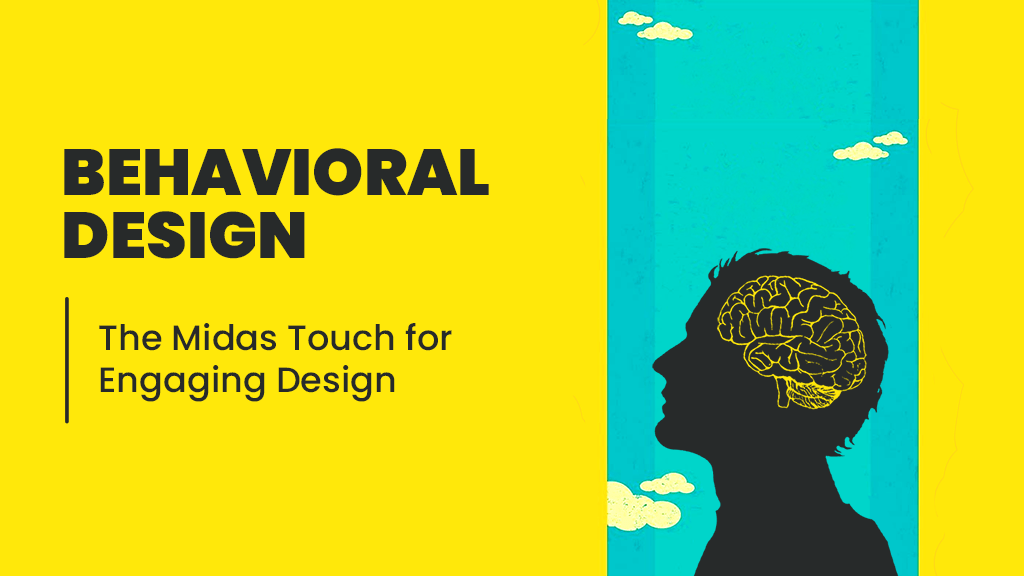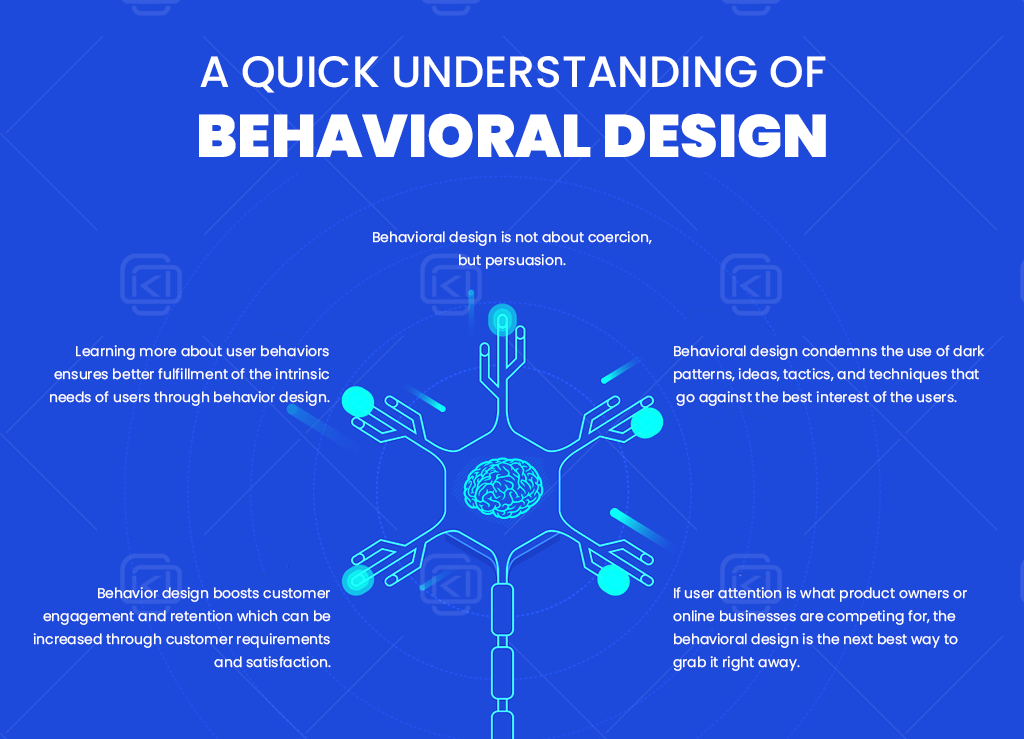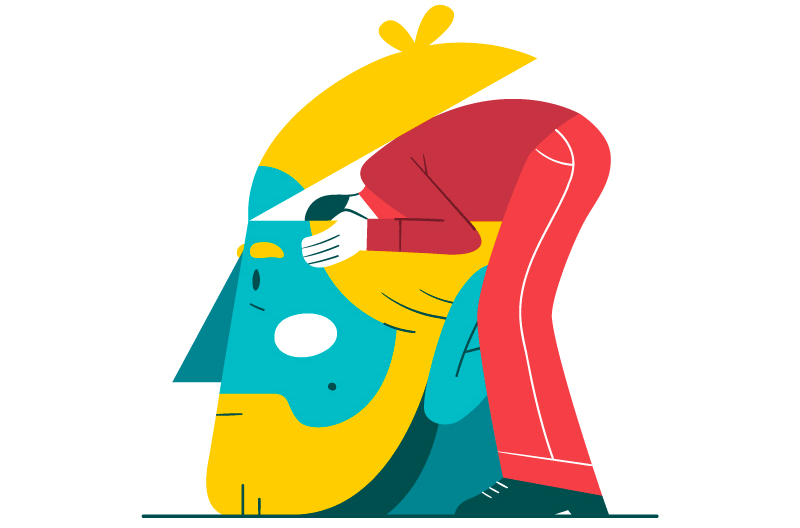


Ever wondered about an ‘ethical’ way to influence people in making certain decisions? Well, then behavioral design patterns are the Midas Touch you’re wondering about.
According to the psychologist, Daniel Kahneman’s work on human decision making, the brain’s operations are divided into two sections, it’s the ‘System-1’ or the fast-moving brain that is responsible for 98% of all our daily thinking and the execution of 35,000 decisions we make every day, unconsciously and automatically.
And the behavioral design is one such technology that can quickly impact this ‘System-1’ part of the brain and help in creating the right environment for people to take actions or make decisions towards specific goals.
When utilized in web designing the right way, it has the power to form habitual routines, encourage the desired behavior, and stop unwanted behaviors from users.
Let’s have a clear idea about what behavioral design is and find out about how it helps in influencing the minds of your target audience, building long-term behaviors in everyday services and products, and shaping their behavior.

The term behavioral design refers to the systematic approach through which behavioral insights are applied for solving design-related challenges that center on human behavior.
In short, the behavioral design process refers to the systematic understanding of how people think or how they make decisions. A subcategory of design, behavioral design is all about how design can shape and influence human behavior.
Combining design with technology, psychology, and different creative methods, behavioral designers find out why exactly people do what they do.
Behavioral design, a perfect combination of Science of Influence and design thinking, is more like a method or framework for systematically and intentionally activating certain behaviors or changing behaviors in people. The techniques that are used to create behavioral product design are deeply rooted in psychology.
For a long time now, psychologists have been studying how humans make decisions. And they have realized that the decisions that humans take in their everyday life are influenced by several factors.
According to the Fogg Behavior Model, there are three major factors responsible for driving human behavior. When a behavior doesn’t take place, it means any one of these three factors is missing. Understanding these behavioral models helps designers better design for behavioral change.
To evoke motivation in users, three different dimensions are used i.e. hope-fear, pain-pleasure, and social acceptance-rejection. Some of the behavioral design techniques that drive motivation, a crucial element for behavior to occur are:
Next comes ability as the second important driving factor for user behavior. And the six main elements that play an important role in boosting user ability are time, physical efforts, brain cycles, money, non-routine, and social deviance.
By reducing the effort and time required to perform a behavior, designers can boost users’ ability. Some of such behavioral designs that increase user ability are:
Prompt is what you need to initiate behavior. According to B.J. Fogg, there are three types of ‘Prompt’ such as signal, spark, and trigger.
For example, the “Reminder’ technique quickly cues users to start a behavior. Serving as a signal to remind users of the target behavior, this technique makes the users more likely to reach their goals.
Usually, when a user lacks motivation, a spark can help start a behavior by combining a motivational element with a signal. Similarly, when users cannot start a behavior, a trigger can help start the behavior. And when people have both motivation and ability, a signal simply helps start the behavior.
Whether you’re a designer or a website owner, as long as there’s something you want your users or visitors to do, implementing different behavioral design techniques following this behavioral model can help you fulfill your objective.

GIF Source: Behavioral Design Hub
Who doesn’t want a successful, engaging, and highly converting website? The answer is everyone who wants to grow their business online.
But is improving the conversion rates of your website easy? No, there are plenty of obstacles on the road to boosting conversion.
No matter how much you toil for making your UX (User Experience) and CX (Customer experience) amazing, it’ll enhance your website’s performance, bring the users to your website but won’t make users act the way you want them to.
Because there’s the ‘human behavior’ part, the ultimate Trump Card for making the conversion happen. Without it, even the finest UX and CX can remain incomplete and fail to deliver.
You don’t know how a user will behave or what action he will take upon arriving on your page. After all, as per the expert, human behavior is the most unpredictable and mysterious obstacle in the online world.
But what if I tell you that by using behavioral design during designing your website, you can persuade the users to take certain actions and boost your website’s conversion rate?
It is believed that if there’re not-so-appealing elements in a website that can influence them to click on the ‘Back’ button; there are undoubtedly such elements that can influence them to stay. And that’s precisely what designing behavior does.
Keeping in mind the influence of technological solutions on human behavior, when you design your website as per the behavior of your customers, the website appeals to them and leads to reduced bounce rates and increased conversion.
Removing friction and motivating users towards action, the behavioral design is believed to offer tangible business profits by enhancing the experience.
Remember, the behavioral design is not about forcing the people or coercion, but persuading them while respecting their fundamental rights to dignity, freedom of choice, and autonomy.
Let’s start from the beginning to help you understand how behavioral design works for a website.
What does the word “experience” mean in UX and CX?
Well, according to a report by Forbes, ‘experience’ is “a series of peak moments”. As per William Leach, the founder of a Behavioral Research & Design Consultancy, to ensure a memorable and engaging experience for the users, designing for the ‘peak moments’ is necessary.
How can you introduce such a design for your website? Well, by taking into consideration the behavior of your customers.
And how exactly can you integrate behavioral design into your website? Or how you can use design to change user behavior? For that, you have to keep these factors in minds, such as:
To understand behavioral designing and make it work, you must know how the human habit system works.
A habit system is nothing but a set of learned behaviors that are performed by people unconsciously. And being learned behaviors, it’s possible to control and influence the consequences of human behavior following the Cue-Action-Reward model. Using this CAR model as a design framework to induce user habits it is possible to ensure continued user retention and engagement.
Do you want to integrate behavioral design into your website to steer customer behavior that can be beneficial to your business but lack the time required for narrowing down the targeted key behaviors and build impactful UX behavioral design?
Then we, Klizo Solutions, can offer you the professional designing assistance you need right now.
Analyzing the behaviors of your customers, their characteristics, their context, and identifying their motivation for performing your desired behavior, our expert designers are here to help you design a website that your audience will find impossible to ignore.
By successfully integrating behavioral design into your website, we ensure that your customers, as well as your users, have a meaningful and memorable experience and behave to match your business aspirations.
Connect us today by clicking here and let our advanced website designing techniques fulfill your business goals.
Previous article
Joey Ricard
Klizo Solutions was founded by Joseph Ricard, a serial entrepreneur from America who has spent over ten years working in India, developing innovative tech solutions, building good teams, and admirable processes. And today, he has a team of over 50 super-talented people with him and various high-level technologies developed in multiple frameworks to his credit.

Subscribe to our newsletter to get the latest tech updates.